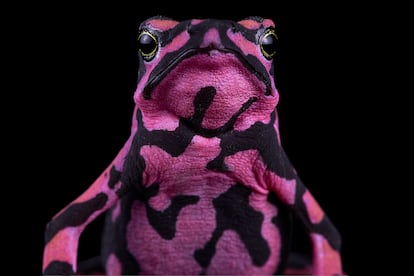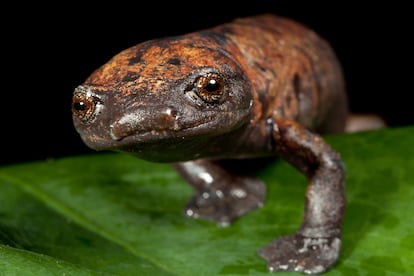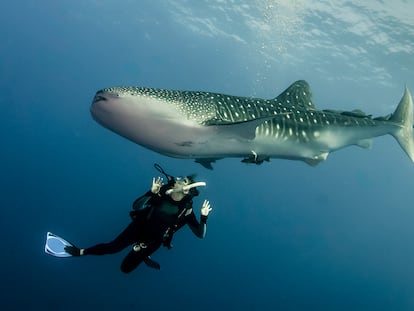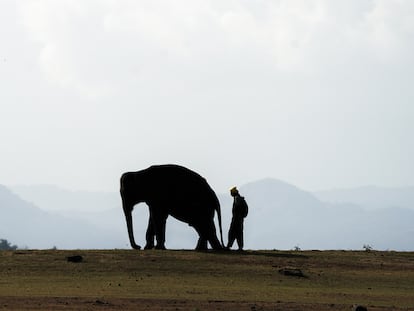Half of all amphibian species are in danger of extinction
A macro report reveals that, if we continue at this rate, two out of every three species could disappear in the coming years

Amphibians (which include frogs and salamanders among other species) are the most endangered group of animals on the planet. Everything seems to be working against their survival: their habitats have been reduced and deteriorated by the advance of agriculture, the logging industry and human infrastructure. In the past two decades, a series of pathogens have decimated them. And so far this century, climate change threatens to put an end to them. A report in which more than a hundred scientists have participated, with additional data from another 900 from around the world, concludes that we must hurry if we want to save them.
The International Union for Conservation of Nature (IUCN) maintains a Red List with the conservation status of all known life. The prestigious journal Nature has just published the second Global Amphibian Assessment (EGA) for this list. The first one was published in 2004. The authors of the report have been able to compare how the more than 8,000 species of frogs, toads, newts and others have fared so far this century. The new EGA hardly has any good news, although there is some.
If we continue at this rate, two out of every three species could disappear in the coming years. The report shows that almost 41% of all amphibian species that have been assessed are vulnerable, endangered or critically endangered (the three worst categories of the Red List classification prior to extinction). This figure contrasts with 26.5% for mammals, 21.4% for reptiles and 12.9% for birds. The 2004 EGA estimated a somewhat lower percentage, 39.4%. But it must be taken into account that the new assessment has added 2,286 species to the list that were not analyzed in the first one. This means that the real number of threatened species has increased.

Threats have also increased. With data dating back to 1980, agriculture has been the traditional global threat. Four out of five species have been affected by its advance. The logging sector and roads, railways and dams have interfered with almost half of the species. In the 2004 EGA, pathogens were already mentioned as a relevant threat. The largest was represented by the amphibian chytrid fungus, which infects frogs until their hearts stop. It has decimated dozens of species during this period. Although it was first described by science in 1999, it must have been devastating amphibian populations for decades. But the new EGA highlights the effects of climate change, which has already worsened the situation of 39% of species, as the main danger for the future.
Bush toads and marsupial frogs are two of the species that climate change could lead to extinction. They are endemic to elevated formations in the form of plateaus or isolated flat mountains typical of Venezuela, and to a lesser extent in Guyana and Brazil. They are know as the tepuis, and the Angel Falls, the highest waterfall in the world, falls from one of them. These two species of amphibians live at these heights, whose isolation makes them unique in the world. Global warming is affecting their habitat intensely, reducing humidity and vegetation cover. Their problem is that they have nowhere to go. Other living beings have responded to climate change by moving further north or higher up. But on the tepuis they can no longer go higher. And descending those vertical walls of more than 2,000 meters does not seem like a good alternative.
“Amphibians are disappearing faster than we can study them”Kelsey Neam,especialista del grupo de anfibios en la Lista Roja de la Unión Internacional para la Conservación de la Naturaleza
Kelsey Neam, co-author of the report and a specialist in the amphibian group on the Red List, warns that “amphibians are disappearing faster than we can study them.” Her colleague Ariadne Angulo, co-author of the work and co-chair of the IUCN amphibian specialist group, highlights how “the second global amphibian assessment confirms our suspicions that the global decline and extinction of amphibians have continued unabated.”
Among amphibians there are three large groups, the anurans (frogs and toads), the caudates (salamanders, newts) and the caecilians, which are reminiscent of worms and are only found in the tropical areas of America. Until not long ago, frogs and toads were the most threatened order, however, so far this century, salamanders have taken over: three out of four already appear as threatened on the Red List.
By large geographic regions, those that accumulate the most threatened species are the Caribbean islands, Central America, the tropical strip of the Andes, the jungles of Cameroon, Nigeria and Madagascar in Africa, and in Asia, the worst is happening in the tropical mountains of India and Sri Lanka. Oceania is the only major region in the world where amphibians have improved their situation. This is influenced by the fact that the amphibian chytrid fungus has not reached Papua New Guinea. In Europe, there is concern about the emergence of another fungus, Bsal, which attacks salamanders.
North America is home to the most biodiverse salamander communities in the world. There is great concern about the possible arrival of the pathogen to the region. “Bsal has not yet been found in the United States, but, given that both humans and other animals can encourage its spread, perhaps it is only a matter of time before a second wave of this lethal disease for salamanders arrives,” says Neam.
The EGA 2004 lists 798 species that could disappear, if they have not already done so, in the coming years. But it has also found 120 species that have improved their status, dropping to the status of Least Concern on the Red List. Of these, 57 improved without human help, recovering from the scourge of fungi. But the rest of the recoveries, almost all concentrated in Costa Rica, Malaysia and India, are due to active habitat protection policies applied so far this century. Maybe that is the way to save the frogs.
Sign up for our weekly newsletter to get more English-language news coverage from EL PAÍS USA Edition
Tu suscripción se está usando en otro dispositivo
¿Quieres añadir otro usuario a tu suscripción?
Si continúas leyendo en este dispositivo, no se podrá leer en el otro.
FlechaTu suscripción se está usando en otro dispositivo y solo puedes acceder a EL PAÍS desde un dispositivo a la vez.
Si quieres compartir tu cuenta, cambia tu suscripción a la modalidad Premium, así podrás añadir otro usuario. Cada uno accederá con su propia cuenta de email, lo que os permitirá personalizar vuestra experiencia en EL PAÍS.
¿Tienes una suscripción de empresa? Accede aquí para contratar más cuentas.
En el caso de no saber quién está usando tu cuenta, te recomendamos cambiar tu contraseña aquí.
Si decides continuar compartiendo tu cuenta, este mensaje se mostrará en tu dispositivo y en el de la otra persona que está usando tu cuenta de forma indefinida, afectando a tu experiencia de lectura. Puedes consultar aquí los términos y condiciones de la suscripción digital.
More information
Últimas noticias
Most viewed
- Reinhard Genzel, Nobel laureate in physics: ‘One-minute videos will never give you the truth’
- Oona Chaplin: ‘I told James Cameron that I was living in a treehouse and starting a permaculture project with a friend’
- Pablo Escobar’s hippos: A serious environmental problem, 40 years on
- Why we lost the habit of sleeping in two segments and how that changed our sense of time
- The fall of a prolific science journal exposes the billion-dollar profits of scientific publishing











































